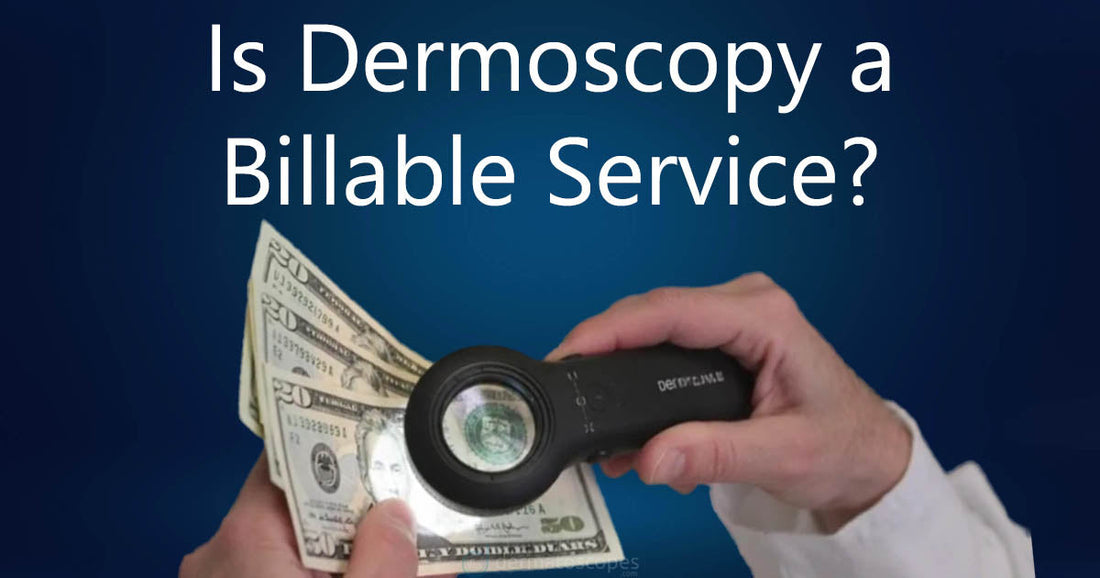One of the most common questions we hear from those who are new to dermoscopy is, "Can I bill for it?" The short answer is no—there is no CPT® code that reimburses for dermoscopy specifically (as a standalone procedure).
Focus on the Findings
The AMA’s CPT code set does not include a Category I code for dermoscopy. While there are codes for dermatologic photography (e.g., 96904 for whole-body integumentary photography, or Category III code 0400T for dermatologic photography with interpretation and report), these describe image capture and reporting—not the routine use of dermoscopy in clinical examination. The AAD has also confirmed (in DermWorld Coding Consult updates) that dermoscopy is considered part of the standard dermatologic examination, not separately billable¹.
So while documenting “dermoscopy performed” may be important clinically, it does not generate separate reimbursement for having done so.
Dermoscopy & MDM
While you cannot bill for dermoscopy as a procedure, the findings can play an important role in supporting the level of evaluation and management (E/M) service reported.
“Total time spent” method of E/M visit calculation notwithstanding, the CPT® E/M guidelines specify that visit level is determined by medical decision making (MDM). The MDM table defines complexity based on three elements²:
- Number and complexity of problems addressed
- Amount and/or complexity of data reviewed and analyzed
- Risk of complications and/or morbidity/mortality of management
Let's Break it Down
Number and complexity of problems:
- Example: A patient presents for a full body skin exam with multiple nevi. Without concerning features, this might represent low-complexity management. But dermoscopic findings of concerning features (atypical pigment networks, blue-white veil, etc.) can elevate the visit to “1 or more undiagnosed new problems with uncertain prognosis,” a criterion for moderate MDM.
Risk of management decisions:
- Example: If dermoscopy suggests that one or more lesions carry malignant potential, the provider must decide between immediate biopsy/excision versus close short-interval monitoring. This risk-based decision making aligns with moderate or high MDM categories, depending on how management is documented.
Data reviewed and analyzed:
- Under CPT® E/M guidelines, the amount and/or complexity of data to be reviewed and analyzed is one of the three MDM elements, with three categories of data recognized²:
- Category 1 (tests/documents): If you review dermoscopic images that were stored in the chart (for example, reviewing an image taken by a member of the nursing staff at the last visit and/or comparing images to baseline), this can be treated like reviewing a “test result” or document.
- Category 2 (independent interpretation): If the dermoscopic photos were taken by staff or another provider, and you provide a documented, signed interpretation that is not separately billed, you may be able to claim this as independent interpretation of a test.
- Category 3 (discussion): If you discuss the dermoscopic images with another clinician (pathologist, Mohs surgeon, referring physician, etc.).
However, In most routine, “real-time dermoscopic exams,” it remains part of your physical exam and does not qualify as a “test reviewed” under the data element. The distinction is in whether images are stored and separately analyzed like a test, versus simply viewed in the exam room.
Real-World Examples
-
Exam only:“Dermoscopy of nevus on the right lateral thigh showed regular pigment network (reassuring).”
- This would be considered part of routine PE, does not count as Category 1 or 2 data.
-
Image capture and review:“Dermoscopy images captured and stored. Current and prior images reviewed. Interpretation: Presence of new irregular streaks along periphery as compared to baseline.”
- Could count toward MDM data reviewed (Category 1).
-
Staff-assisted imaging with provider read:“Medical assistant obtained dermoscopic photos of four nevi. Physician interpretation: lesion on back demonstrates atypical pigment network; biopsy advised.”
- Can count as category 2 independent interpretation, supports higher MDM.
To Get "Credit" For Your Work, Always:
- Document what was seen rather than vague “dermoscopy performed” phrasing.
- E.g. “Dermoscopic exam of lesion on the right temple revealed presence of slate-gray dots and granules arranged around follicular openings.”
- Link findings to management impact.
- E.g., “Lesion warrants biopsy based on dermoscopic features observed” or “Due to presence of slightly atypical pigment network, follow-up in 3 months recommended.”
- Remember, it’s not the tool (dermatoscope) that increases complexity, but the clinical significance of the findings and the management implications (but only if they’re documented!).
- Dermoscopists tend to “make mental observations and calculations,” but E/M code assignment is all about documentation of those observations and calculations. Whenever the dermoscopic findings influence the treatment plan to any significant degree, the answer to the question “What was seen dermoscopically and how did it affect the treatment plan?” should be clearly found in the notes.
Bottom Line
- Technically, you cannot bill for dermoscopy as a procedure itself.
- The coding-assignment value of dermoscopy lies in its ability to influence and guide risk-based decision making.
- Thorough documentation of dermoscopic findings and their impact on management can support higher-level E/M coding under CPT® guidelines.
References:
- DermWorld Coding Consult, March 2025. American Academy of Dermatology.
- CPT® Professional 2024. American Medical Association: Evaluation and Management Services Guidelines (99202–99215).

.png?v=1667978305)
